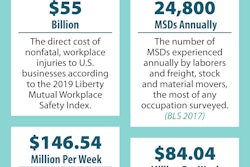
You operate in a sea of data.
You track things like total recordable incident rates, rejects, overall equipment effectiveness, lost-time injury frequency rate, throughput, order processing and downtime.
And for good reason. All of this data helps you remove bottlenecks and make processes more efficient. It helps you increase yield and accuracy, and decrease costs without sacrificing quality. It allows you to keep safety incidents low and frontline performance high so you can stay competitive. To sum it up, data let’s you make smarter decisions, faster.
But in that rush to move forward faster, frontline employees are getting left behind. Amid all the data points out there, learning’s often not one of them. And when learning is tracked, it’s usually in terms of participation and cost—which is the wrong kind
of data.
Read Next: 5 Supply Chain Professionals You Need to Know
So, what data should you track when it comes to training your people? Simple. The same things tracked across the business: impact on performance and the bottom line.
Yes, Learning Drives Business Results
All business targets share a common denominator. People. A business’ ability to reach its goals depends on its workforce doing the right things at the right time.
Want to reduce safety incidents, for example? Make sure your people know the correct procedures for handling dangerous equipment and hazardous materials. Want to reduce scrap? Train operators on the processes specific to your operation.
Training is about influencing and changing the behaviours that impact your business metrics most.
Measuring that connection seems impossible. Even an army of data scientists couldn’t tie a test score to a business result. But with the right approach and the right technology, manufacturers can now link training programs to their business goals and see how much of an impact learning has on their operations. And they can do it in real time.
Much of this is thanks to machine learning and artificial intelligence (AI). By collecting massive volumes of learning data that goes beyond test scores, manufacturers can uncover the true connection between frontline training, behavior change and business KPIs.
First You Have to Change Your Approach
Before that happens, you need to think about how training is delivered in complex environments where frontline employees are busy and hard to reach.
Here’s how learning tends to go: when frontline employees need training, they’re pulled off the floor for hours- or days-long training sessions where they’re overwhelmed with a lot of one-size-fits-all content all at once.
But here’s the rub. This kind of training doesn’t engage employees. It doesn’t drive enough participation to make a difference. It doesn’t capture the data you need to make better decisions. And it doesn’t keep up with the rate of change in your business. Plus, the numbers are stacked against firehose-style learning.
Read Next: Improve Your Training Through Coaching and Mentoring
According to the forgetting curve, people forget 70 percent of information within the first 24 hours (that number jumps to 90 percent if information isn’t reinforced within 30 days). So, by the time they get back on the floor, most employees forget the majority of what they learned.
When employees forget, they do one of two things: make a judgment based on their experience, or ask a co-worker for help (which relies on that co-worker’s judgment and experience). Sometimes it’s right, sometimes it’s wrong. But every time, it’s just a best guess.
Thus, before you can start impacting business outcomes, you need to help employees remember what they’ve learned first.
Always Be (Micro)learning
If you’ve never heard the term before, microlearning is all about delivering ultra-relevant information, in short bursts, reinforced over time. In other words, it’s the polar opposite of the traditional, long-form methods of training we’re used to.
Here’s what microlearning looks like: at the beginning of each shift, employees spend three to five minutes laser-focused on a handful of things they need to know to perform better on the frontlines. That process repeats every day, building on new concepts and reinforcing ones they’ve already learned.
Because each session is so short, it fits naturally into the daily work schedule. Which means microlearning can happen on the floor, at convenient times during the day, so employees never stop being productive. Like anything else on the job, it too becomes a habit.
Using the same technologies that link learning to your business goals, microlearning personalizes what each employee needs to know. So, if an employee’s falling behind on safety protocols, for example, they’ll get targeted information to bring them back up to speed.
At the end (figuratively speaking, because with microlearning training never ends), each employee should have (and maintain) the knowledge and behaviors they need to excel at their job.
Read Next: Supply Chain Visibility in the Age of Customization: Orchestrating Arrivals of Parts and Components for Highly Personalized Products
Part Two
In the December issue of Supply & Demand Chain Executive, we’ll explore part two of this article: employee engagement; KPI tracking; and program implementation.



















